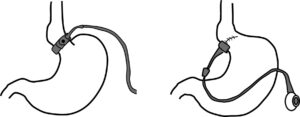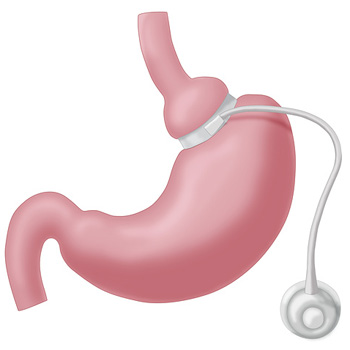Are you considering gastric banding surgery? If so, you’re not alone. This type of surgery is becoming increasingly popular, and for good reason. Gastric banding surgery can help you lose weight and improve your health. But it’s important to understand what this type of surgery involves before you make a decision. In this blog post, we will discuss everything you need to know about gastric banding surgery. We’ll cover the benefits, the risks, and the recovery process. We’ll also dispel some common myths about gastric banding surgery. By the end of this post, you will have a better understanding of what to expect if you decide to undergo this type of surgery.
Contents
Defining Gastric Banding Surgery
Gastric banding surgery is a type of weight-loss surgery. It is also known as laparoscopic adjustable gastric banding (LAGB) or simply gastric banding. This surgery is performed by placing a band around the stomach, which creates a small pouch at the top of the stomach. This pouch holds less food, so you will feel full sooner and eat less overall. Gastric banding surgery is considered a restrictive type of weight-loss surgery because it limits how much you can eat.
There are two types of gastric bands: inflatable and adjustable. Inflatable bands are filled with saline solution after they are placed around the stomach. Adjustable bands do not need to be inflated and can be tightened or loosened as needed. Both types of bands are equally effective.
Commonly known as the stomach stapling surgery, gastric bypass is a bariatric weight loss surgery that reduces the size of your stomach. It has become one of the most popular weight loss surgeries in recent years.
Who Should Undergo Gastric Banding Surgery?

Gastric banding surgery is usually recommended for people who are obese. To be considered a candidate for this type of surgery, you must typically have a body mass index (BMI) of 40 or higher. You may also be a candidate if you have a BMI of 35 and are experiencing obesity-related health problems, such as type II diabetes or sleep apnea.
In addition to people struggling with weight issues, gastric banding surgery may also be an option for people who have undergone other weight-loss surgeries but have not been successful in losing weight.
Who Should Avoid Gastric Banding Surgery?
There are some people who should avoid gastric banding surgery, even if they are struggling with obesity. This type of surgery is not recommended for pregnant women or people who have active ulcers, cancer, or other serious health conditions. This surgery is also not an option for people who are unable to commit to making lifestyle changes, such as following a healthy diet and getting regular exercise.
Moreover, gastric banding surgery is not a quick fix for weight loss. It is a serious surgery that requires a lifelong commitment to healthy eating and exercise. If you are not willing to make these changes, gastric banding surgery is not right for you.
How Does Gastric Banding Surgery Work?

Gastric banding surgery is performed through small incisions in the abdomen. A laparoscope (a thin, lighted tube) is inserted into one of the incisions. The surgeon uses the laparoscope to place the band around the top of the stomach. The other end of the band is attached to an access port, which is placed just under the skin on the abdominal wall.
The surgeon then adjusts the tightness of the band by injecting or removing saline solution from the access port. The amount of saline solution injected or removed will determine how tight or lose the band is. As a result, you will feel fuller sooner and eat less overall. Gastric bypass surgery is considered a mixed type of weight-loss surgery because it both restricts food intake and prevents the absorption of calories and nutrients.
The surgeon will make adjustments to the band based on your weight-loss goals and how well you are tolerating the surgery. The surgery procedure is usually performed as an outpatient procedure, which means you can go home the same day. The surgery takes about 30 minutes to an hour to perform. You will likely stay in the hospital for one to two nights so that your health can be monitored.
Myths About Gastric Banding Surgery
There are a lot of myths about this surgery. Some of the most common misconceptions include:
- Surgery is a quick fix for weight loss: This is not true. Gastric banding surgery is a serious surgery that requires a lifelong commitment to healthy eating and exercise.
- It is dangerous: While any surgery comes with some risk, gastric banding surgery is considered safe when performed by a qualified surgeon.
- One will never be able to eat normally again: This is not true. You will be able to eat normally after gastric banding surgery, but you will need to make sure that you are eating healthy foods in small portions.
- It is expensive: The cost of gastric banding surgery varies depending on the surgeon and the location of the procedure. However, it is usually covered by insurance.
If you are considering gastric banding surgery, it is important to do your research and talk to your doctor to make sure it is the right choice for you.
What To Expect?
Just like with any other medical procedure, there are certain things you might want to be aware of before, during and also after the surgery
Before the surgery

You will be asked to follow a special diet in the weeks leading up to your surgery. This diet will help shrink your liver, making the surgery safer and easier to perform. You will also be asked to stop taking certain medications and supplements that can increase bleeding during surgery.
It is important that you are at your ideal weight before undergoing gastric banding surgery. If you are not, your surgeon may recommend that you lose weight through diet and exercise or consider another weight-loss surgery.
You will also be asked to sign a consent form before the surgery. This form ensures that you understand the risks, benefits, and alternatives to the procedure.
During the surgery
Gastric banding surgery is usually performed as an outpatient procedure, which means you can go home the same day. The surgery takes about 30 minutes to an hour to perform. You will likely stay in the hospital for one to two nights so that your health can be monitored.
After the surgery
You will need to follow a special diet for the first few weeks after surgery. This diet will help your stomach heal and adjust to the smaller size. You will also need to take vitamin and mineral supplements for the rest of your life to prevent malnutrition. You will also have drains placed under your skin to help remove excess fluid. These drains will be removed before you leave the hospital.
It is important to attend all of your follow-up appointments so that your health can be monitored. Your surgeon will need to adjust the tightness of the band as you lose weight. You may also need additional surgery to remove the band if it does not work for you.
If you experience any complications after surgery, you should contact your surgeon immediately. These complications can usually be resolved with a simple adjustment to the band.
You will need to stay in the hospital for one to two nights so that your health can be monitored. You may experience some pain and discomfort after the surgery, but this can be managed with pain medication.
Benefits
There are many benefits of gastric banding surgery. This type of surgery has been shown to be effective in helping people lose weight and keep it off long term. In fact, studies have shown that people who undergo gastric banding surgery can lose up to 50% of their excess body weight.
Gastric banding surgery can also help improve or resolve other health conditions, such as:
- High blood pressure
- High cholesterol
- Sleep apnea
- Type II diabetes
Another benefit of gastric banding surgery is that it is usually reversible. If you decide that you no longer want the band, it can be removed. In addition, it is also considered a safer option than other types of weight-loss surgery, such as gastric bypass surgery. This is because it does not involve any cutting or stapling of the stomach. Gastric banding surgery is also reversible if necessary.
Risks

As with any type of surgery, there are risks associated with gastric banding surgery. These risks include:
- Bleeding
- Infection
- Reaction to anesthesia
- Blood clots
- Pneumonia
- Ulcers
- Gastrointestinal leaks
It may also lead to dumping syndrome, which is a condition that occurs when food moves too quickly from the stomach to the small intestine. Dumping syndrome can cause symptoms such as diarrhea, sweating, and lightheadedness.
Most of these risks are rare and can be effectively managed by your surgeon. It is important to discuss the risks of gastric banding surgery with your doctor before making a decision about whether or not to undergo the procedure.
Recovery
The recovery from gastric banding surgery is typically fairly quick. Most people feel well enough to return to their normal activities within a week. You will likely need to take some time off from work, but this will depend on the type of job you have. You should avoid strenuous activity for at least four weeks after surgery.
It is important to follow your surgeon’s instructions during your recovery. This includes attending all of your follow-up appointments and following a healthy diet and exercise plan. Surgery is only a tool that can help you lose weight, but it is not a miracle cure. You will need to make lifestyle changes in order to lose weight and keep it off long-term.
Alternatives
If you are considering gastric banding surgery, you may want to consider some alternatives first. These alternatives can be of two types: invasive and non-invasive.
Invasive alternatives include:
- Gastric bypass surgery: This type of surgery involves creating a small pouch in the stomach and attaching it directly to the small intestine. This allows food to bypass the rest of the stomach, which can lead to weight loss.
- Sleeve gastrectomy: This type of surgery involves removing a portion of the stomach so that it is smaller. This can help you feel full after eating less food.
Non-invasive alternatives include:
- Intragastric balloon: This is a temporary device that is placed in the stomach through the mouth. It takes up space in the stomach so that you feel fuller after eating less food.
- Endoscopic sleeve gastroplasty: This is a non-surgical procedure that involves placing stitches in the stomach to create a smaller stomach pouch.
- Diet and exercise: This is the most common alternative to weight-loss surgery. Making healthy lifestyle changes can help you lose weight and keep it off long term.
- Medications: There are a number of medications that can help you lose weight. These medications can be used alone or in combination with diet and exercise.
All these alternatives have their own set of risks and benefits. It is important to discuss all of your options with your doctor before making a decision about which one is right for you.
Conclusion
If you are considering gastric banding surgery, be sure to discuss all of your options with your doctor. Undergoing medical surgery is a serious decision and should not be taken lightly. There are risks involved with any type of surgery, but these risks can be effectively managed by an experienced surgeon. Surgery can help you lose weight and improve your health, but it is not a miracle cure. You will need to make lifestyle changes in order to lose weight and keep it off long-term.
If you want to learn more about weight loss techniques and benefits, you may reach out to Mantra Care. We have a team of highly professional nutritionists and dietitians offering guidance and plans for weight loss. You may visit our website for more information and bookings.


